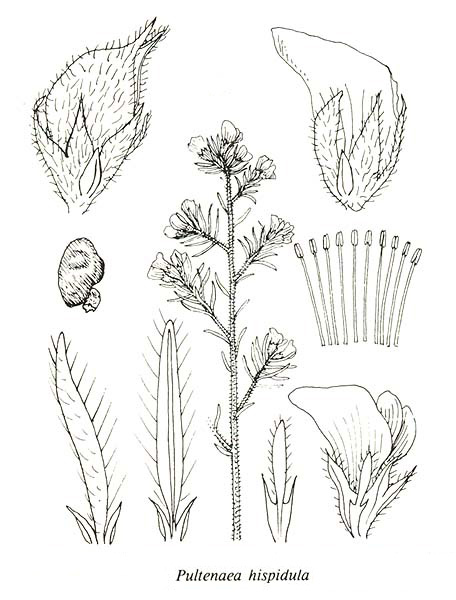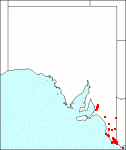Family: Fabaceae
Pultenaea hispidula
Citation:
R. Br. ex Benth., Fl. Aust. 2:133 (1864).
Synonymy: P. graveolens Tare,Trans. R.Soc. S. Aust. 7:68 (1885); P. graveolens Tate var. glabrescens J. Black, Fl. S. Aust. 299 (1924); P. pubescens H.B. Williamson ex J. Black, Fl. S. Aust. 301 (1924).
, Pultenaea daltonii Common name: Rusty (or scented) bush-pea.
Description:
Small erect much branched shrub, to 1 m high, with drooping branches, with rusty-coloured hairs; leaves linear-obtuse, 3-10 x 0.7-1.5 mm, petiolate, concave, channelled or 1-furrowed above by involute margins, the midrib scarcely conspicuous, hirsute or scabrous below, to glabrescent; stipules at first triangular, c. 0.5 mm long, yellow, fleshy and viscid, later scarious and brown, or lanceolate and to 1.5 mm long when midrib ending in a point, with hyaline ciliate margins.
Flowers 5-8 mm long, subsessile or on pedicels 1-3 mm long, pubescent with short curly hairs, few (rarely 1 or 2), firstly in terminal proliferous heads, becoming axillary later, rarely at first on short lateral branches; bracts suborbicular, c. 2 mm long, often 2-lobed, reddish-brown, scarious, sometimes with a few white hairs or wanting when replaced by modified stipules of the floral leaves; bracteoles attached to the base of the calyx, highly variable, ovate and yellowish-brown, often viscid, in length not exceeding the tube of the calyx, or narrow-linear to subulate with reddish ciliate membranous margins basally or stipulate, often leaf-like or completely replaced by stipulate floral leaves far exceeding the tube in length; calyx 3-4 mm long, velutinous to glabrescent, teeth lanceolate, mostly ciliate, upper 2 falcate, longer than the tube, lower acuminate and shorter than the tube; standard suborbicular, 7-9 mm wide, yellow to pale-orange with red markings on the back, suddenly contracted into a c. 1.5 mm long claw; wings oblong-obovate, yellow or tinted purple-brown, auriculate above the claw; keel angular-obovate, obtuse, red or crimson distally; ovary and base of style villous.
Pod ovate or obovate, 4-5 mm long, somewhat turgid, brown, villous; seed reniform-obovoid, 1.5-2.5 mm long, turgid, brown-black, shiny.

| Pultenaea hispidula twig, leaves, bract, flowers, free stamens, legume and seed.
|
Image source: fig 364a in Jessop J.P. & Toelken H.R. (Ed.) 1986. Flora of South Australia (4th edn).
|
Published illustration:
Corrick (1981) Victorian Nat. 98:43, fig. 20 as P. graveolens; Costermans (1981) Native trees and plants of south-eastern Australia, p. 191.
|
|
Distribution:
|
S.Aust.: SL, KI, SE. Qld; N.S.W.; Vic.
|
Conservation status:
native
Flowering time: Aug. — Dec.
|

SA Distribution Map based
on current data relating to
specimens held in the
State Herbarium of South Australia
|
Biology:
No text
Taxonomic notes:
There is considerable variation in plants from different localities. Plants from FR have a more uniform habit with glabrescent subsessile leaves and mostly axillary flowers with short viscid bracteoles. The specimens from SL and SE show diversity in combinations of different characters in leaves, disposition of inflorescence and bracteoles and it has been decided not to recognise Tate's species here and to place Williamson's species, previously synonymised by Willis (1972) Handbook to plants in Victoria 2:272 under P. hispidula.
Author:
Not yet available
|

